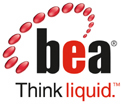Related Research Articles

Jakarta EE, formerly Java Platform, Enterprise Edition and Java 2 Platform, Enterprise Edition (J2EE), is a set of specifications, extending Java SE with specifications for enterprise features such as distributed computing and web services. Jakarta EE applications are run on reference runtimes, which can be microservices or application servers, which handle transactions, security, scalability, concurrency and management of the components they are deploying.
Camunda provides a workflow and decision automation platform offering process orchestration capabilities to organizations of any size. Camunda Platform comes from years of research and development including open source initiatives.

WebObjects is a discontinued Java web application server and a server-based web application framework originally developed by NeXT Software, Inc.

BEA Systems, Inc. was a company that specialized in enterprise infrastructure software products, which was wholly acquired by Oracle Corporation on April 29, 2008.
Maven is a build automation tool used primarily for Java projects. Maven can also be used to build and manage projects written in C#, Ruby, Scala, and other languages. The Maven project is hosted by The Apache Software Foundation, where it was formerly part of the Jakarta Project.

Business Process Model and Notation (BPMN) is a graphical representation for specifying business processes in a business process model.

The XML Process Definition Language (XPDL) is a format standardized by the Workflow Management Coalition (WfMC) to interchange business process definitions between different workflow products, i.e. between different modeling tools and management suites. XPDL defines an XML schema for specifying the declarative part of workflow / business process.
The Spring Framework is an application framework and inversion of control container for the Java platform. The framework's core features can be used by any Java application, but there are extensions for building web applications on top of the Java EE platform. The framework does not impose any specific programming model.. The framework has become popular in the Java community as an addition to the Enterprise JavaBeans (EJB) model. The Spring Framework is free and open source software.
jBPM is an open-source workflow engine written in Java that can execute business processes described in BPMN 2.0. jBPM is a toolkit for building business applications to help automate business processes and decisions. It's sponsored by Red Hat, part of the JBoss community and closely related to the Drools and OptaPlanner projects in the KIE group. It is released under the ASL by the JBoss company.
JBoss Developer Studio (JBDS) is a development environment created and currently developed by JBoss and Exadel.
Business process management (BPM) is the discipline in which people use various methods to discover, model, analyze, measure, improve, optimize, and automate business processes. Any combination of methods used to manage a company's business processes is BPM. Processes can be structured and repeatable or unstructured and variable. Though not required, enabling technologies are often used with BPM.

Spring Roo is an open-source software tool that uses convention-over-configuration principles to provide rapid application development of Java-based enterprise software. The resulting applications use common Java technologies such as Spring Framework, Java Persistence API, Thymeleaf, Apache Maven and AspectJ. Spring Roo is a member of the Spring portfolio of projects.
This article provides a comparison of Business Process Model and Notation (BPMN) tools.
Bonita is an open-source business process management and low-code development platform created in 2001. Bonita technology was developed originally in 2001 by Miguel Valdés Faura, at the French Institute for Research in Computer Science and Automation, and subsequently transferred to Groupe Bull. In 2009, the Director of the BPM division, Miguel Valdes Faura, founded Bonitasoft, which is a French open-source software vendor.

Activiti is an open-source workflow engine written in Java that can execute business processes described in BPMN 2.0. Activiti is the foundation for Alfresco's Alfresco Process Services (APS) and Alfresco is the Activiti project's leading sponsor.

Sparx Systems Enterprise Architect is a visual modeling and design tool based on the OMG UML. The platform supports: the design and construction of software systems; modeling business processes; and modeling industry based domains. It is used by businesses and organizations to not only model the architecture of their systems, but to process the implementation of these models across the full application development life-cycle.